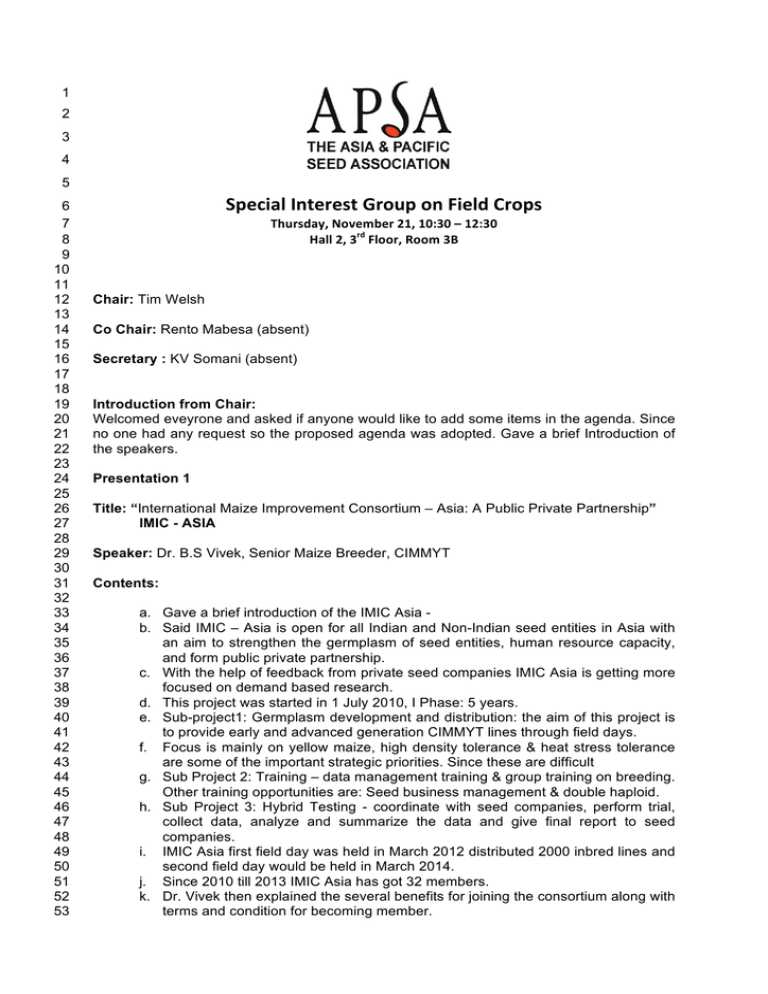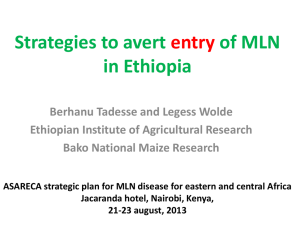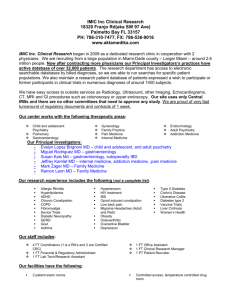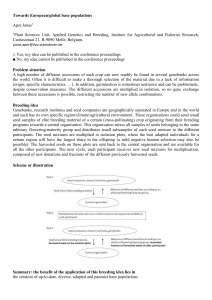Document 10775255
advertisement

1 2 3 4 5 6 7 8 9 10 11 12 13 14 15 16 17 18 19 20 21 22 23 24 25 26 27 28 29 30 31 32 33 34 35 36 37 38 39 40 41 42 43 44 45 46 47 48 49 50 51 52 53 Special Interest Group on Field Crops Thursday, November 21, 10:30 – 12:30 Hall 2, 3rd Floor, Room 3B Chair: Tim Welsh Co Chair: Rento Mabesa (absent) Secretary : KV Somani (absent) Introduction from Chair: Welcomed eveyrone and asked if anyone would like to add some items in the agenda. Since no one had any request so the proposed agenda was adopted. Gave a brief Introduction of the speakers. Presentation 1 Title: “International Maize Improvement Consortium – Asia: A Public Private Partnership” IMIC - ASIA Speaker: Dr. B.S Vivek, Senior Maize Breeder, CIMMYT Contents: a. Gave a brief introduction of the IMIC Asia b. Said IMIC – Asia is open for all Indian and Non-Indian seed entities in Asia with an aim to strengthen the germplasm of seed entities, human resource capacity, and form public private partnership. c. With the help of feedback from private seed companies IMIC Asia is getting more focused on demand based research. d. This project was started in 1 July 2010, I Phase: 5 years. e. Sub-project1: Germplasm development and distribution: the aim of this project is to provide early and advanced generation CIMMYT lines through field days. f. Focus is mainly on yellow maize, high density tolerance & heat stress tolerance are some of the important strategic priorities. Since these are difficult g. Sub Project 2: Training – data management training & group training on breeding. Other training opportunities are: Seed business management & double haploid. h. Sub Project 3: Hybrid Testing - coordinate with seed companies, perform trial, collect data, analyze and summarize the data and give final report to seed companies. i. IMIC Asia first field day was held in March 2012 distributed 2000 inbred lines and second field day would be held in March 2014. j. Since 2010 till 2013 IMIC Asia has got 32 members. k. Dr. Vivek then explained the several benefits for joining the consortium along with terms and condition for becoming member. 54 55 56 57 58 59 60 61 62 63 64 65 66 67 68 69 70 71 72 73 74 75 76 77 78 79 80 81 82 83 84 85 86 87 88 89 90 91 92 93 94 95 96 97 98 99 100 101 102 103 104 105 106 107 108 109 110 l. m. n. o. p. q. r. Said after becoming the member of the consortium they will access to the inbred lines along with several optional activities such as training, testing, Hybrid rights etc. IMIC – Asia steering committee comprised of 5 member committee in which 2 members are from IMIC, 2 members from CIMMYT and 1 non-member, so that accountability in functioning of IMIC can be ensured. They have recently inaugurated Mize DH facility for Africa, where they wish to offer DH service for nominal fee. Dr. Vivek then explained several challenges that are associated with MCMV virus that affect in Maize crops predominantly in Eastern Africa. They have also published a paper on MLN facts and actions. They have developed several inbred lines with MLN resistance along with MLN screening facility in Naivasha. Welcomed members of APSA and new members to join IMIC-Asia. Q&A/Comments/Discussions 1. Bhupen – Advanta India: The Agronomic: climate change is shifting focus of crops from late to mid and from mid to early varieties. Answer by Dr. Vivek: Needs are evolving and once we get such requirement from our members then we can also shift our focus. 2. Mr. Reddy – Nugenes Pvt Ltd: Are DH inbred lines are available for consortium members only? Answer b Dr. Vivek: They are available but with some nominal fees 3. Tim Welsh: The system of doing regional trials for companies that would send samples from outside India. Answer by Dr. Vivek: We are currently working on this however companies can send samples through co-ordination with IMIC India on some international trial station. The Cahir then asked everyone that if anyone interested in becoming member then they can leave their contact details so that they can get back to them. Presentation 2 Title: “New Maize Breeding Technologies and progress in Improving Drought Tolerance and Aflatoxin Resistance with native genes from exotic germplasm” Speaker: Dr. Wenwei Xu, Corn Breeder and Associate Professor of Corn Breeding & Genetics, Texas A&M University Contents: a. Said the need of hour is to improve the food production in-order the combat the rising demand with the rise in population and decrease in Agricultural land area. b. One of the key requirements is to increase the yield we need to have better germplasm, adopt transgenic traits. Use Genomics and molecular breeding tools are helpful in finding the target genes and with the help of molecular markers one can incorporate the target genes into elite germplasm. c. Dr. Xu then described how Double Haploid method is used in-order to develop In bred lines along with some of the details of how genes are transferred and how we can identify the DH line. d. High throughput phenotyping methods are also very useful but it very much depended on trained people and expensive machines. 111 112 113 114 115 116 117 118 119 120 121 122 123 124 125 126 127 128 129 130 131 132 133 134 135 136 137 138 139 140 141 142 143 144 145 146 147 148 149 150 151 152 153 154 155 156 157 158 159 160 161 162 e. Dr. Xu then showed the field pic of new equipment’s which would allow breeders to plant and evaluate genotypes in different environment so that they can collect more uniform and accurate phenotypic data for selection. Also he showed some of the latest sophisticated equipment’s used for harvesting. f. Breeding for Drought tolerance & Aflatoxin resistance drought tolerance is extremely important in the high plains in the U.S as there is low rainfall, decline in water level and increase in pumping cost. g. He then described the strategy for breeding the drought tolerant corn along with evaluation and improvement of the h. Drought stress can depend upon the local environmental condition. i. The best stage to impose draught stress is two weeks after pollen shedding (at flowering stage). j. Source of Drought Tolerant genes – CIMMYT material, GEM (Germplasm Enhancement of Maize), Ex Patent expired proprietary lines (Ex-PVP lines). k. In order to reduce Aflatoxin contamination risk is to apply non-toxic A.flavus strain or use resistant hybrid (which are very few in USA) l. Germplasm Enhancement of Maize (GEM) Project: More than 60 collaborators, two permanent breeding sites (1. Ames, IA for dev. Of 25% tropical and temperate and 2. Raleigh, NC for development of 50% tropical). m. Dr. Xu then explained the breeding protocol under GEM n. He showed data of disease resistance varieties from which it can be proved that the new developed lines can have good resistance towards Aflatoxin. o. At present some of their inbred lines are commercial stage. p. He concluded by saying exotic germplasm can be very useful to improve stress tolerance & disease resistance, modern mechanical equipment’s are critical for breeders to evaluate a large number of genotypes. Q&A/Comments/Discussions 1. Dr. Vivek: In one of the pictures we have seen two rows of green plants and two row of dry so are have they issue with combine to handle such situations? Answer by Dr. Xu: You can harvest there can’t be any issue if you have adequate moisture. 2. Dr. Tim Welsh: How many breeding row you are doing to justify using such high priced equipment? Answer by Dr. Xu: We have 500 harvest every day and we try help other farmers who are in 300 mile range, that way we help each other. The chair then asked if there are any suggestions or question from the members group regarding CIMMYT program then they can contact us or leave their contact details so that they can get back to them. The Chair then presented memento to the respective speakers. Meeting was then adjourned. Minutes of meeting prepared by Rahul Mishra 21st November 2012





